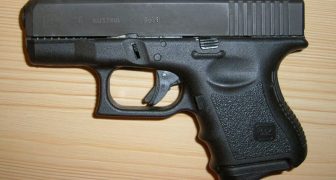Big Bore Lever Action Rifles
This is a guest post by Andrew Betts
Cars too fast, girls too pretty, and a defensive firearm that is too powerful. Do such things even exist? When it comes to the defensive use of a firearm, we want to stop the bad guy and we want him to stop in a right now sort of way. Often, more powerful guns mean bigger holes, more damage, and a faster stop, or at least that is the conventional wisdom. If a Super Death-Blasto-matic is good, then a Super Nitro Magnum Death-Blasto-matic is better, right?
Okay, so it isn’t a Super Nitro Magnum Death-Blasto-matic but .450 Marlin is an impressively powerful cartridge.

.450 Marlin on the left, compared to the .458 Winchester Magnum
On the high speed portion of that test, it looks like a truck drove through that gelatin and never tapped the brakes. How can that NOT be a good thing for defense?
To be sure, this load would ruin a bad guy’s whole day, maybe even his week. It is undeniably powerful, delivering well over a ton and a half ton of energy into the target. No, I didn’t stutter. A .44 mag fired from a revolver produces less than half as much energy as this load. It also has substantial recoil. It feels similar to a 12 gauge 2 ¾” load but with a little slower push. Unfortunately, it penetrates more deeply than is usually desirable for home defense.
Nearly two feet of gelatin is well over the FBI recommended maximum of 18” of penetration for defensive firearms. This, combined with the relatively low capacity and heavy recoil when compared to a carbine chambered in an intermediate cartridge makes it somewhat less than ideal for most homeowners.
In terms of capacity, damage, recoil, and rate of fire, it compares nicely to a 12 gauge pump, which many folks favor for home defense. Being a rifle, it can legally have a barrel two inches shorter than the shotgun without expensive  paperwork. It does not hurt that it is more precise, especially if the only target a presented by the bad guy was a very small one. 20 inches of penetration means that it presents a very real, legitimate risk to uninvolved parties, though.
paperwork. It does not hurt that it is more precise, especially if the only target a presented by the bad guy was a very small one. 20 inches of penetration means that it presents a very real, legitimate risk to uninvolved parties, though.
After penetrating the requisite 12”-14” to incapacitate a bad guy, this load still has the mass and velocity to pass through many intermediate obstacles. It is true that ANY cartridge that is capable of reliably incapacitating a bad guy will pass through multiple walls, but this load is likely to make it through more walls, dressers, refrigerators, and Justin Bieber posters than other popular defensive cartridges. This makes it a very risky choice for most people because most people live where most other people live: in the city or suburbs.
While it may not be ideal for the average homeowner, it might be nearly perfect for someone who lives where large animals such as black bears or mountain lions could be as likely a threat as notionally “human” predators. The extra penetration is always useful for taking a little vinegar out of a large animal and isn’t so much of a liability for human aggressors as it would be in the city or suburbs.
That massive expansion and fragmentation combined with the ridiculously large temporary cavity means that a hit to the thoracic cavity should result in faster incapacitation than many other cartridges are capable of producing. It is also capable of delivering accurate hits at greater distance than a shotgun can normally manage. The penetration, damage, and precision are all features that homesteaders in rural areas are likely to find useful.
Is there such a thing as too much of a good thing? Certainly. Are big bore lever actions best suited for defense for the average home owner? Well, maybe not, but they’re not a terrible choice. For some homesteaders, a big bore lever action might actually be the best choice.
Andrew Betts served with the Arizona National Guard for over 12 years, including a tour to Afghanistan. Visit his YouTube Channel for more great shooting information.


Speak Your Mind